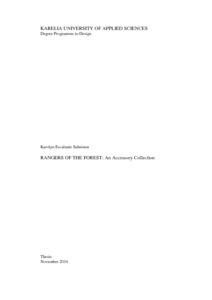Rangers of the Forest: An Accessory Collection
Escalante Salminen, Karolyn (2014)
Escalante Salminen, Karolyn
Karelia-ammattikorkeakoulu (Pohjois-Karjalan ammattikorkeakoulu)
2014

Creative Commons Attribution-NonCommercial-ShareAlike 3.0 Unported
Julkaisun pysyvä osoite on
https://urn.fi/URN:NBN:fi:amk-2014120318183
https://urn.fi/URN:NBN:fi:amk-2014120318183
Tiivistelmä
The following thesis describes the research and development processes followed in order to create an accessory collection. This project has been developed collaboratively with Hanhi, a textile and interior design company. The concept of the collection is based on the symbology found within the Finno-Ugric shamanistic folklore. In an attempt to consider waste management problems, the materials used to create this collection are mainly discarded pieces of fabric.
Firstly, the knowledge foundations are established throughout the research stage of this paper. This research deepens into subjects such as folklore and shamanism. The research focuses mainly on the characteristics concerning the Finno-Ugric geographical area. Subsequently, a detailed explanation of the symbol identification and conceptualization stages is provided. The conceptualization process includes a description of the general message and purpose of the collection. Afterwards, a detailed description of the design, experimentation, and production processes takes place, followed by a conclusion and evaluation. The evaluation area includes comments given by the commissioning company.
The main outcomes of this project are prototypes of an accessory collection. It is of high importance to mention that this report follows the design and production processes only until the prototype phase. Further development is still under discussion.
Firstly, the knowledge foundations are established throughout the research stage of this paper. This research deepens into subjects such as folklore and shamanism. The research focuses mainly on the characteristics concerning the Finno-Ugric geographical area. Subsequently, a detailed explanation of the symbol identification and conceptualization stages is provided. The conceptualization process includes a description of the general message and purpose of the collection. Afterwards, a detailed description of the design, experimentation, and production processes takes place, followed by a conclusion and evaluation. The evaluation area includes comments given by the commissioning company.
The main outcomes of this project are prototypes of an accessory collection. It is of high importance to mention that this report follows the design and production processes only until the prototype phase. Further development is still under discussion.
